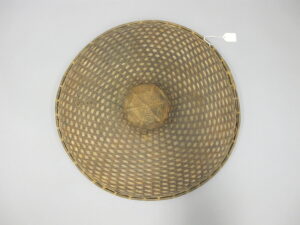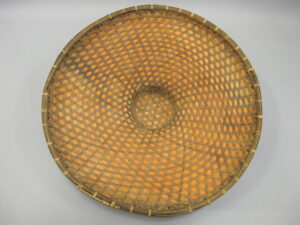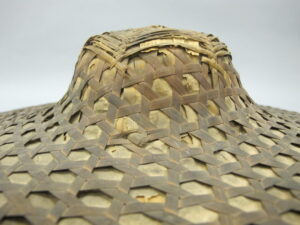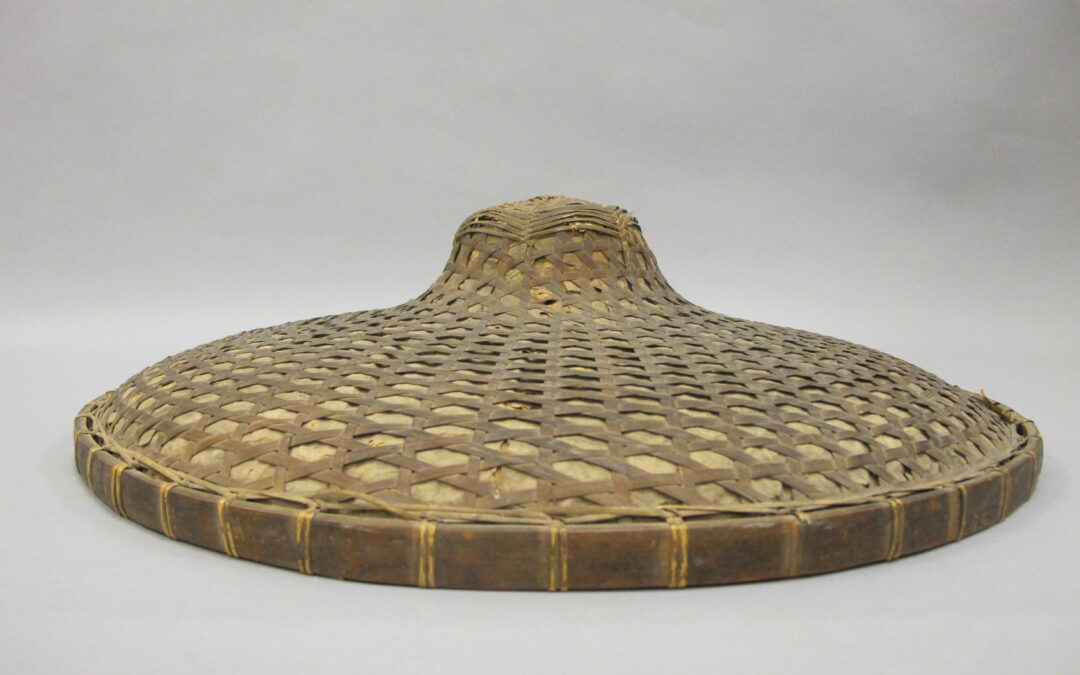As we embrace the vibrant month of May, we come together to celebrate Asian American and Pacific Islander (AAPI) Heritage Month— a time to recognize and honor the profound contributions, rich cultures, and diverse histories of AAPI communities across the United States. We are delighted to share an article by the Sutter’s Fort Curatorial Department that delves into a hat from the expansive Sutter’s Fort Museum Collection.
Nearly all Chinese immigrants to California in the nineteenth century came from the Guangdong province near the South China Sea. We know this not because of any English language documentation but from a few Chinese language documents and individual family histories. For many who came seeking California gold the details of their lives are added to the masses of unknown human history and we, modern historians, are left to speculate. We know that a man called Ah Foo owned this hat. We know that he was born in China in 1840 and spent most of his life mining in El Dorado County. For any more details of his life, we can only question how much his experienced conformed to what we know about others who share in common the few aspects of him we know of, a young man from China who joined the millions of others around the world in the California Gold Rush.
Beginning in 1852 into the 1860s the port of San Francisco annually received between six and seven thousand people from China after a journey of two months at sea. Over their shoulders bedding, clothing, and a few personal items were often wrapped around either end of a chord of bamboo poles while in their hands they carried the large fan like leaves of palm trees and woven hats of bamboo. As the men filed out from below deck, they were met on the dock by San Francisco police to be inspected for contraband. No survey, no name taking, no documentation whatsoever was taken by California officials through the 1850s and 60s— that was left to the Chinese Benevolent Association, better known as the Six Companies.
Agents of the companies would greet newcomers at the dock along with the city police. Once cleared of contraband and under the care of a company, new arrivals were escorted a few blocks up the hill to Chinatown. The companies provided local employment and connections to Chinese communities growing in the interior of the state. Most migrated toward the mines. Many came with prior mining experience or had some supplemental knowledge of the trade. Chinese mining companies arranged themselves according to the business hierarchies and pay systems used in the trade back home making the operation smoother and more organized than most. Constructing flumes, waterwheels, and pumps was something other mining companies often hired Chinese to do for them knowing that their knowledge and capabilities were superior.
Today, it is very difficult to research individual Chinese persons that came to California in the nineteenth century. Only the Six Companies kept record of the comings and goings of Chinese immigrants and most of their historic documents were destroyed in San Francisco’s earthquake and subsequent fire in 1906. For many, the decennial federal American census is the earliest, only, and often flawed documentation of their presence.
No documentation of Ah Foo’s arrival in California exists, though later censuses indicate that he came to the U.S. in 1855 at the age of 15. The first census to document what is verifiably him isn’t until 1870. There he is listed as living with seven other Chinese men all identified as miners. Ten years later, in 1880, the now 40-year-old Ah Foo is sited as a partner in a mining company among three other men of Chinese birth. He would continue to mine for at least another twenty years. By 1912 he was living with and working for Margaret Kelley, founder of the James Marshall Pioneer Museum in Kelsey.
It was through the attainment of the James Marshall Museum collection from Ms. Kelley that Ah Foo’s hat came into the Sutter’s Fort Collection. In 1928, when the acquisition took place, the Fort collection gained over 2,000 objects from Ms. Kelley, ten of which belonged to Ah Foo. A hat, a pipe, a teapot, a dish for soy Sause, and a few other household items. Some of these items are on display at the Joss House in Weaverville and at Marshall Gold in Coloma today while the rest are kept here at our collection’s facility.
It is likely that Ah Foo made the hat himself. In keeping with a traditional Chinese manner of weaving long thin strips of bamboo into hats, this one displays a ‘triaxial plaiting’, in which three strips of bamboo are woven in a manor creating hexagonal patterns. For this hat, the maker replicated this pattern for an inner and outer layer with paper lining in between. The crown of the hat has an alternative hexagonal pattern overlaying the original pattern. All of this is contained within a large round bamboo rim and held together by twine. Photos of the time indicate that this sort of hat was near omnipresent among Chinese workers in California, be they in the mine or on the rail line. Yet due to the decomposable nature of bamboo very few remain intact.
We at the Sutter’s Fort Curatorial Department will continue to preserve the material memory of Ah Foo, and many others, with the utmost care.



About the Sutter’s Fort Collection
In addition to the historic structures at Sutter’s Fort SHP, Friends of Sutter’s Fort also is committed the preservation of the many artifacts that are part of the Sutter’s Fort Collection. This expansive collection of artifacts is housed both at Sutter’s Fort, and at the State Museums Collections Center, which is also managed by California State Parks. Read more about the collection here.

